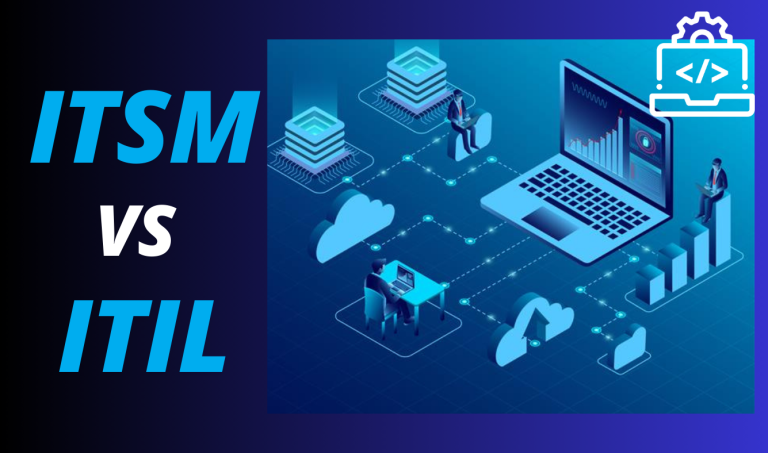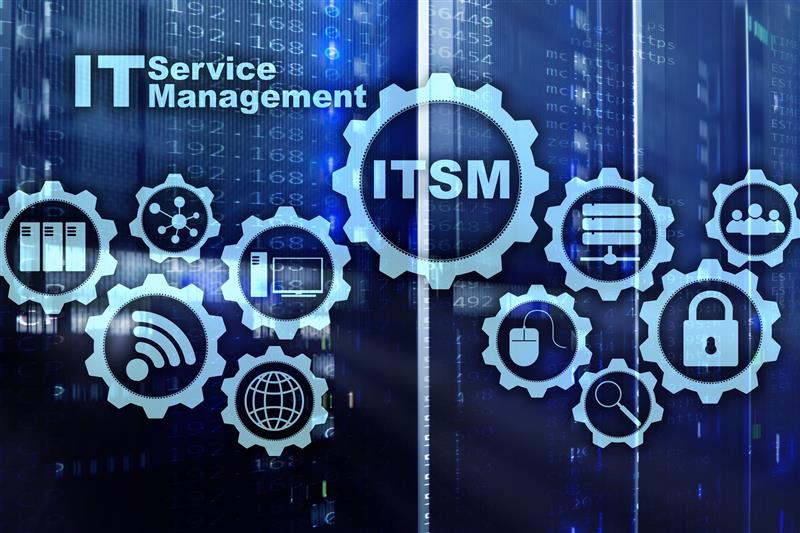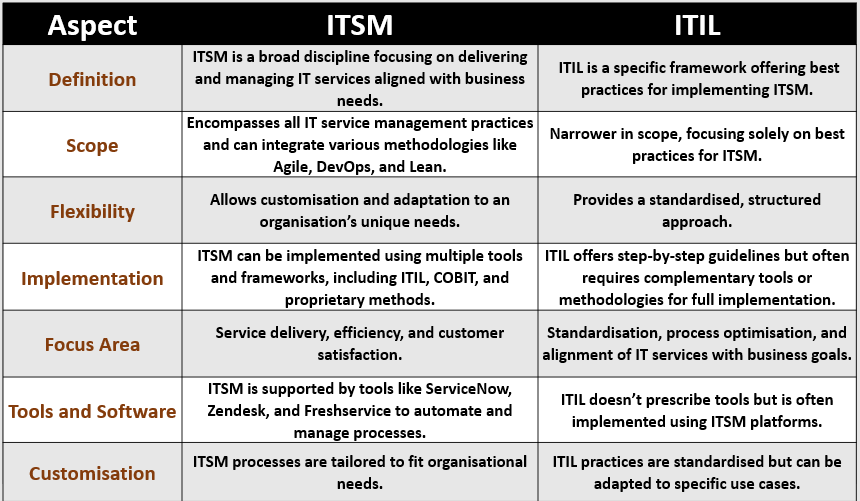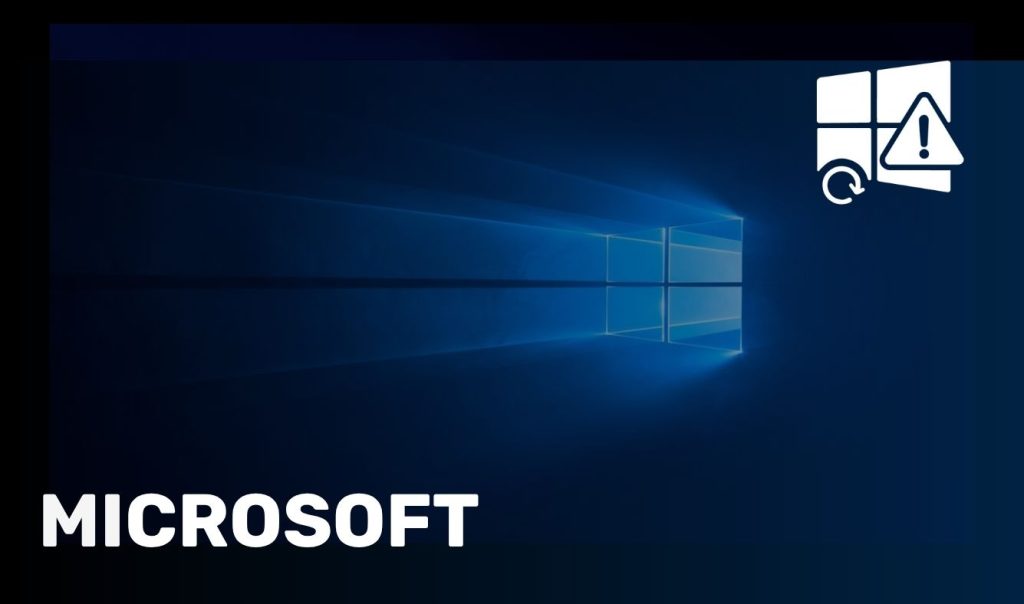In the evolving landscape of IT management, two terms often surface: IT Service Management (ITSM) and Information Technology Infrastructure Library (ITIL). While these concepts are closely connected, they are not interchangeable. Understanding their differences, purposes, and how they complement each other is critical for organisations aiming to streamline operations and enhance IT service delivery.
This blog dives deep into ITIL and ITSM, ITSM vs ITIL, exploring their definitions, differences, and why they are essential for modern businesses.

What Is ITSM?
IT Service Management (ITSM) refers to the processes, policies, and practices that organisations use to design, deliver, manage, and optimise IT services. It’s a holistic approach focusing on aligning IT services with business goals and ensuring maximum value for end-users.
Benefits of ITSM
- Enhanced Service Delivery:
ITSM ensures consistent and reliable IT services, reducing downtime and disruptions. Clear processes allow organisations to maintain operational performance and meet end-user expectations effectively. - Alignment with Business Goals:
By aligning IT operations with organisational objectives, ITSM drives growth and innovation. It bridges the gap between technical operations and business priorities, fostering a competitive edge. - Cost Optimisation and Efficiency:
ITSM minimises operational costs through streamlined workflows and resource management. It reduces redundancies, leverages automation, and ensures a high ROI on IT investments. - Improved User Experience and Collaboration:
ITSM enhances user satisfaction with customer-focused features like self-service portals and rapid problem resolution. It also promotes collaboration across teams by defining clear roles and responsibilities, fostering seamless communication. - Regulatory Compliance and Scalability:
ITSM frameworks align with global standards like ISO/IEC 20000, ensuring compliance and risk mitigation. The adaptable nature of ITSM supports growth, enabling organisations to scale their IT services in response to evolving needs.

What Is ITIL?
Information Technology Infrastructure Library (ITIL) is a globally recognised framework that provides best practices for ITSM. It offers a structured approach to IT service management, focusing on aligning IT services with business requirements while ensuring consistency and efficiency.
Comprehensive Benefits of ITIL
- Structured ITSM Framework:
ITIL provides a comprehensive set of best practices for implementing ITSM, ensuring consistency and clarity in service management operations. Its structured approach helps organizations maintain efficiency and control. - Service Quality and Value Creation:
Focused on continual service improvement, ITIL helps maintain high-quality services by proactively identifying and addressing areas for enhancement. It emphasises aligning IT services with customer needs to create tangible business value. - Risk Management and Agility:
ITIL offers detailed guidance on change management, security, and risk mitigation, minimizing operational vulnerabilities. Its compatibility with modern methodologies like Agile and DevOps supports organisations during digital transformation. - Efficient Resource Utilisation:
ITIL optimises the use of resources, avoiding waste and maximizing IT investments. It ensures resources are allocated efficiently to support critical services and projects. - Collaboration, Compliance, and Scalability:
ITIL fosters collaboration by establishing a shared language among IT teams and stakeholders. It simplifies regulatory compliance and adapts to the needs of organisations of all sizes, making it scalable across industries.

ITSM vs ITIL: Key Differences
Scope:
- ITSM encompasses the entire spectrum of IT service management practices, including various frameworks and methodologies.
- ITIL is a specific set of guidelines within the ITSM domain, providing detailed best practices for service management.
Flexibility:
- ITSM allows organisations to adopt and tailor processes based on their unique needs, potentially integrating multiple frameworks.
- ITIL offers a standardised approach, which organizations can adapt to varying degrees, but it remains a specific methodology.
Implementation:
- ITSM can be implemented using various frameworks, including ITIL, COBIT, or proprietary models.
- ITIL provides a structured approach to implementing ITSM processes, often serving as a foundation for ITSM initiatives.

How ITIL and ITSM Work Together
While ITSM is a broader concept, ITIL serves as a blueprint for implementing ITSM processes effectively. Think of ITSM as the “what” and ITIL as the “how.” For organizations seeking to optimise IT operations, using ITIL to guide ITSM adoption ensures consistency, efficiency, and alignment with best practices.
When used together, ITSM and ITIL offer a powerful combination of strategic oversight and actionable frameworks. ITSM sets the broad goals for service delivery, while ITIL provides the roadmap for achieving those goals. This synergy results in improved efficiency, reduced costs, and services that align perfectly with business objectives.
The Importance of ITSM and ITIL for Businesses
Why ITSM Matters:
- Improved Efficiency: Streamlines IT operations by automating and standardizing processes.
- Enhanced Customer Experience: Focuses on minimizing downtime and delivering prompt, reliable services.
- Cost Management: Optimizes resource usage and reduces unnecessary expenses.
- Alignment with Business Goals: Ensures IT services directly contribute to organizational objectives.
Why ITIL Matters:
- Global Recognition: As a standardised framework, ITIL is widely accepted, making it easier to benchmark performance.
- Process Standardization: Provides consistency across IT operations, improving service quality.
- Scalability: Scales with organizational growth, adapting to increased complexity and demands.
- Compliance: Helps organizations adhere to regulatory requirements and industry standards.
Choosing the Right Approach
Deciding whether to implement ITIL vs ITSM, or both depends on your organisation’s goals, size, and IT maturity level.
- Small to Medium Businesses (SMBs): SMBs may focus on core ITSM processes tailored to their immediate needs. ITIL can provide foundational guidance without requiring full-scale implementation.
- Large Enterprises: Larger organizations benefit from ITIL’s structured approach, ensuring standardized processes across departments and regions. Combining ITIL with robust ITSM tools like ServiceNow can drive scalability and efficiency.
- Dynamic Startups: Agile startups might adopt ITSM practices without adhering strictly to ITIL. Flexibility and quick iteration are often more critical for startups in fast-changing environments.
The Future of ITSM and ITIL
As technology evolves, ITSM and ITIL continue to adapt. Emerging trends like AI, automation, and predictive analytics are transforming IT service management. ITIL 4, the latest version of the framework, incorporates modern methodologies like Agile and DevOps, making it more relevant for today’s digital-first organizations.
By integrating these advancements, businesses can enhance their IT capabilities, driving innovation and staying competitive in an increasingly complex landscape.
Contact Creative Networks Today
At Creative Networks, we specialise in helping businesses implement IT solutions tailored to their unique needs. Whether you’re starting your IT service management journey or looking to refine your existing processes, our team of experts is here to help.
Contact us today to transform your IT operations and align your technology with your business goals. Let’s build a smarter, more efficient IT future together.




